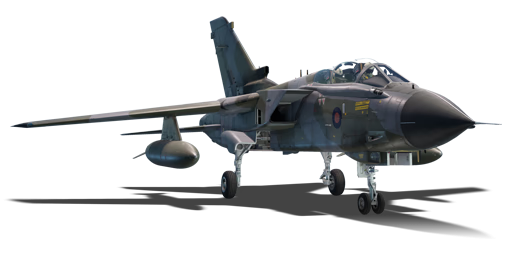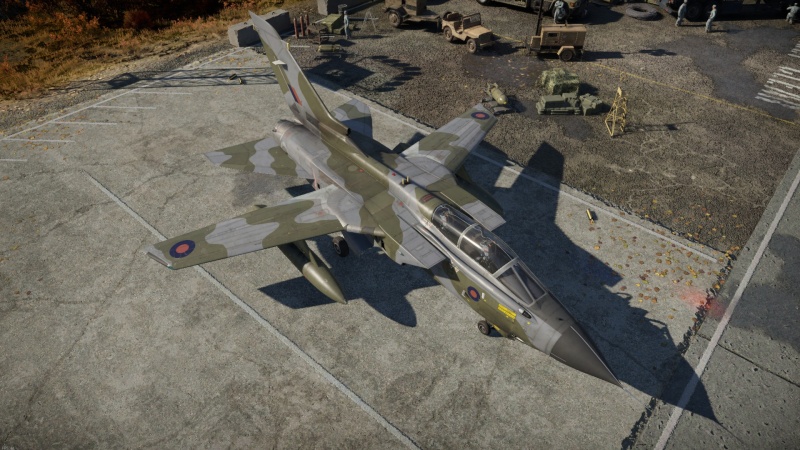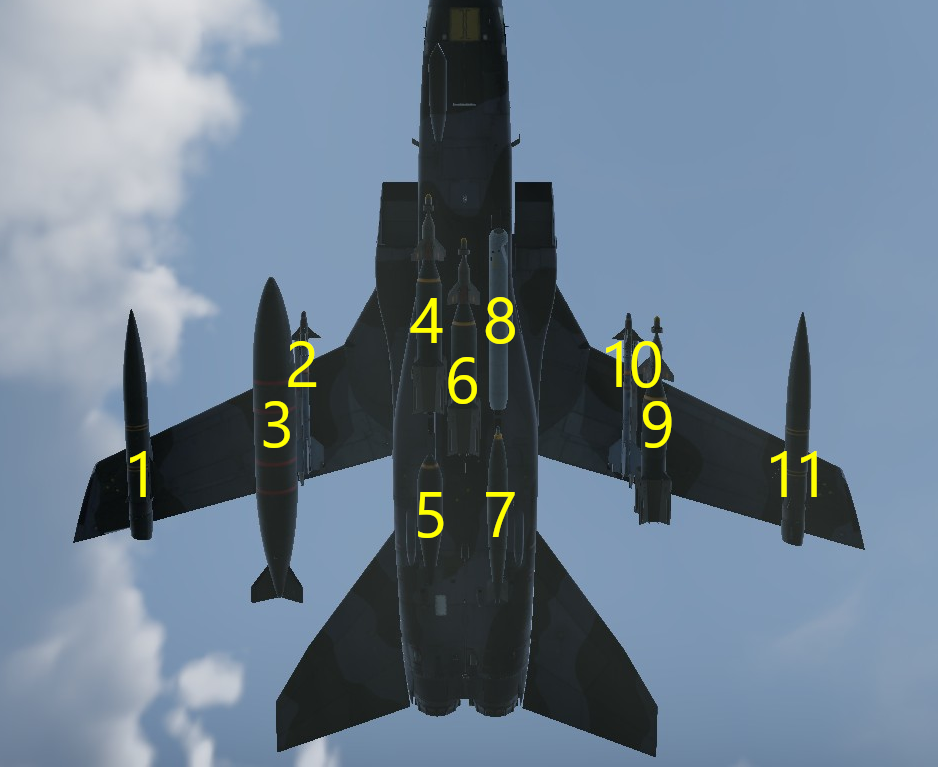Tornado GR.1
| This page is about the British strike aircraft Tornado GR.1. For other versions, see Tornado (Family). |
Contents
Description
The Panavia Tornado GR.1 stands as a testament to its lasting impact within the Royal Air Force, spanning from its debut in the late 1970s to its operational tenure until the turn of the millennium. The Tornado GR.1's exceptional versatility was further underscored during Operation Desert Storm in the early 1990s, where it executed precision strikes with remarkable precision, solidifying its reputation as a potent force in modern aerial warfare. As the new millennium dawned, the aircraft continued to serve valiantly, being a key asset in peacekeeping missions and coalition operations in various theatres, including Bosnia and Kosovo. The Panavia Tornado GR.1's legacy extends beyond its operational prowess; it symbolizes the RAF's commitment to operational innovation and its ability to evolve to meet the changing demands of global security scenarios.
The Tornado GR.1 was introduced in Update "Apex Predators", a versatile and multifaceted aircraft poised to reshape the lacking CAS capabilities of British tech-tree. This remarkable aircraft seamlessly adapts to the role of a versatile multi-role warrior, skillfully engaging both ground and aerial targets across an array of scenarios. With a flexible array of armaments at its disposal, the Tornado GR.1 stands ready to confront a wide spectrum of challenges, from lightly armoured targets able to be taken out with rockets, to entrenched ground targets. As it materializes as underappreciated, the Tornado GR.1 silently emerges as a potent ground assailant, utilizing its capacity for precision strikes from a calculated distance, unsettling even the most vigilant of anti-aircraft units with Precision Guided Munitions (PGM). Tailored to pilots who revel in the intricate dynamics of multifaceted operations and diverse weapon configurations, the Panavia Tornado GR.1 beckons to those who traverse the skies with a combination of deliberate patience and honed skill.
General info
Flight performance
| Characteristics | Max speed (km/h at 10,972 m) |
Max altitude (metres) |
Turn time (seconds) |
Rate of climb (metres/second) |
Take-off run (metres) | |||
|---|---|---|---|---|---|---|---|---|
| AB | RB | AB | RB | AB | RB | |||
| Stock | 1,979 | 1,958 | 12800 | 31.4 | 31.5 | 153.7 | 149.7 | 800 |
| Upgraded | 2,035 | 2,005 | 30.6 | 31.0 | 202.3 | 177.0 | ||
Details
| Features | |||||
|---|---|---|---|---|---|
| Combat flaps | Take-off flaps | Landing flaps | Air brakes | Arrestor gear | Drogue chute |
| ✓ | ✓ | ✓ | ✓ | ✓ | X |
| Limits | Wings (km/h) | Gear (km/h) | Flaps (km/h) | Max Static G | |||
|---|---|---|---|---|---|---|---|
| Combat | Take-off | Landing | + | - | |||
| Min sweep | 972 | 0 | 1,166 | 552 | 440 | ~8 | ~3 |
| Max sweep | 1,555 | ~9 | ~3 | ||||
| Optimal velocities (km/h) | |||
|---|---|---|---|
| Ailerons | Rudder | Elevators | Radiator |
| < 670 | < 650 | < 700 | N/A |
Engine performance
| Engine | Aircraft mass | |||||||
|---|---|---|---|---|---|---|---|---|
| Engine name | Number | Basic mass | Wing loading (full internal fuel) | |||||
| Turbo-Union RB199-34R Mk.101 | 2 | 14,309 kg | 634 kg/m2 | |||||
| Engine characteristics | Mass with internal fuel (no weapons load or external fuel) | Max Gross Weight | ||||||
| Weight (each) | Type | 17m fuel | 20m fuel | 30m fuel | 45m fuel | 58m fuel | ||
| 968 kg | Afterburning low-bypass turbofan | 15,836 kg | 16,054 kg | 16,926 kg | 18,234 kg | 19,399 kg | 25,910 kg | |
| Maximum engine thrust @ 0 m (RB/SB) | Thrust to weight ratio @ 0 m (WEP) | |||||||
| Condition | 100% | WEP | 17m fuel | 20m fuel | 30m fuel | 45m fuel | 58m fuel | MGW |
| Stationary | 3,633 kgf | 7,015 kgf | 0.89 | 0.87 | 0.83 | 0.77 | 0.72 | 0.54 |
| Optimal | 4,032 kgf (1,400 km/h) |
7,845 kgf (1,400 km/h) |
0.99 | 0.98 | 0.93 | 0.86 | 0.81 | 0.61 |
Survivability and armour
The Tornado has no armour to speak of and is relatively large, making it an easy target for enemy guns. Almost any hit to the center part of the Tornado will leave its speed crippled, while any hit to the wings and tail will most likely cripple flight performance, if not disabling the aircraft outright. Although it could in theory make its way back to base even with only one engine, any enemy attention during this timespan will most likely get you sent back to the hangar. It also has 2 pilots, which means that you can continue flying in the unlikely case that only 1 pilot is knocked out.
Modifications and economy
Armaments
| Ballistic Computer | ||||
|---|---|---|---|---|
| CCIP (Guns) | CCIP (Rockets) | CCIP (Bombs) | CCRP (Bombs) | Lead indicator |
| |
|
|
|
|
Offensive armament
The Tornado GR.1 is armed with:
- 2 x 27 mm Mauser BK27 cannons, chin-mounted (180 rpg = 360 total)
This Tornado has a pair of autocannons loaded primarily with APHE (one more that it's fighter equivalent). A single tap of the "fire" button should be enough to destroy howitzers and other unprotected targets from 3 km away, should pilot not miss.
The guns also receive aim assist from the radar at about 1.5 km range. The radar tracker is super focused despite not having a pulse-doppler technology, therefore the guns rarely miss when using it and pilot can easily attack an enemy wing from behind or at ground level, where radar missiles of enemies are irrelevant.
Suspended armament
The Tornado GR.1 can be outfitted with the following ordnance:
| 1 | 2 | 3 | 4 | 5 | 6 | 7 | 8 | 9 | 10 | 11 | ||
|---|---|---|---|---|---|---|---|---|---|---|---|---|
| 1,000 lb H.E. M.C. Mk.13 bombs | 1, 2 | 1, 2‡ | 1, 2‡ * | 1*‡ | 1, 2‡ * | 1, 2‡ | 1, 2 | |||||
| 1,000 lb H.E. M.C. Mk.13 No.117 bombs | 1, 2 | 1, 2‡ | 1, 2‡ * | 1*‡ | 1, 2‡ * | 1, 2‡ | 1, 2 | |||||
| 1,000 lb LDGP Mk 83 bombs | 1, 2 | 1, 2‡ | 1, 2‡ * | 1*‡ | 1, 2‡ * | 1, 2‡ | 1, 2 | |||||
| 546 kg Mk.13 bombs | 1† | 1† | 1*†‡ | 1†* | ||||||||
| 404 kg PGM 500 bombs | 1 | 1* | 1* | 1 | ||||||||
| 1,060 kg PGM 2000 bombs | 1 | 1* | 1* | 1 | ||||||||
| 2,000 lb GBU-24 Paveway III bombs | 1*† | |||||||||||
| AIM-9L Sidewinder missiles | 1 | 1 | ||||||||||
| Large calibre countermeasures | 28 | 28 | ||||||||||
| TIALD targeting pod | 1† | |||||||||||
| 1,500 l drop tanks | 1 | 1 | ||||||||||
| * Marked guided bombs on hardpoints 4/8 cannot be equipped with bombs on hardpoint 6 or hardpoints 5/7 respectively † TIALD targeting pod must be equipped when using marked guided bombs ‡ Bombs on hardpoint 6 cannot be equipped with dual bomb mounts on hardpoints 4-8 | ||||||||||||
| Default weapon presets | |
|---|---|
| |
Usage in battles
There are multiple ways to use the Tornado in ARB, one tactic is to stick to the team and try and give support with your AIM-9Ls on your way to the enemy bases and/or ground targets. This gives you the advantage of team cover and a bit of safety, although you will undoubtedly be in the midst of battle once enemy interceptors and fighters reach your team. The other tactic would be to go full throttle directly to the enemy bases while keeping extremely low to the ground to decrease your chances of being spotted visually or by radar. While this leaves you mostly alone and isolated from the possible support of your team, you will be able to take a more direct route to your main target, meaning you'll be able to evade any slower or unsuspecting enemies. Taking an active role in air-to-air combat is not advised, as the Tornado's flight performance is not suited to it and you'll most likely be shot down very quickly. So keep in mind that although the Tornado is fast, its not very manoeuvrable at high speed so try to avoid faster enemies such as the F-16 or the F-14. In the case of 1-to-1 confrontation the best option is to simply hope you are faster and run away, against capable fighters like the MiG-23, F-16, MiG-29, Viggen, F-14, and Mirage 2000 you don't stand a chance, unless the enemy pilot is extremely inexperienced. With countermeasures you are able to survive for longer if you can time their use and can dodge without losing too much of your speed. In GRB you can easily pick off enemy SPAA once you have unlocked your laser guided bombs, so try to fly as high as possibile. If you only have dumb bombs you're going to need to stick to the ground as much as possibile to avoid enemy AA, you can't linger too much on the battlefield or else the enemy team will begin to prioratise you as a target. You also need to be very weary of what type of enemy air has been spawned in, if you focus too much on ground vehicles you become easy pickings for any enemy aircraft which can take advantage of you not realising they're there. In conclusion, play a reserved role and only engage when you think its clear.
Pros and cons
Pros:
- Variable sweep wing, can be used as a fighter after bombing if necessary
- Large payload and is supersonic
- Unlike other Tornado bombers, can carry TV bombs, including 1 ton versions
- Although it's slower than other Tornado bombers, it is also much more stable
Cons:
- Can struggle in air-to-air combat, doesn't have as many countermeasures as the rest of British planes at the tier to compensate
- High fuel consumption
- Full bombing loadout severely limit its maximum speed to about Mach 1.05
- TV bombs cannot even be dropped above Mach 1
- No search radar for planning around enemies
- Can destroy itself by rolling too much if "New boosters" are equipped
History
The Panavia Tornado GR.1 was a multi-role combat aircraft, the result of an international collaboration between British, German and Italian companies which in 1969 formed the Panavia company to manufacture the Tornado. Its first flight was 14th August 1974 and was introduced to the RAF in 1986 but its first use in combat was not until 1991 in the Gulf war and was in service until March 2019.
Media
- Skins
See also
External links
| Panavia Aircraft GmbH | |
|---|---|
| Strike Aircraft | Tornado (Family) |
| Germany | ◄Tornado IDS WTD61 · ◄Tornado IDS ASSTA1 · ◄Tornado IDS MFG |
| UK | Tornado GR.1 · Tornado GR.4 · Tornado F.3 · Tornado F.3 Late |
| Italy | Tornado ADV · ▄Tornado IDS · ▄Tornado IDS (1995) |
| Britain jet aircraft | |
|---|---|
| Blackburn | Buccaneer S.1 · Buccaneer S.2 · Buccaneer S.2B |
| British Aerospace | Harrier GR.7 · Sea Harrier FRS.1 (e) · Sea Harrier FRS.1 · Sea Harrier FA 2 |
| British Aircraft Corporation | Strikemaster Mk.88 |
| English Electric | Canberra B Mk 2 · Canberra B (I) Mk 6 · Lightning F.6 · Lightning F.53 |
| Gloster | Meteor F Mk 3 · Sea Meteor F Mk 3 · Meteor F Mk 4 G.41F · Meteor F Mk 4 G.41G · Meteor F Mk 8 G.41K · Meteor F Mk.8 Reaper |
| Javelin F.(A.W.) Mk.9 | |
| de Havilland | Vampire F.B.5 · Venom FB.4 · Sea Venom FAW 20 · Sea Vixen F.A.W. Mk.2 |
| Hawker | Sea Hawk FGA.6 · Hunter F.1 · Hunter F.6 · Hunter FGA.9 · Harrier GR.1 · Harrier GR.3 |
| Panavia | Tornado GR.1 · Tornado GR.4 · Tornado F.3 · Tornado F.3 Late |
| SEPECAT | Jaguar GR.1 · Jaguar GR.1A · Jaguar IS |
| Supermarine | Attacker FB 1 · Attacker FB.2 · Scimitar F Mk.1 · Swift F.1 · Swift F.7 |
| Foreign | Phantom FG.1 (USA) · Phantom FGR.2 (USA) · F-4J(UK) Phantom II (USA) |
| Australia | F-111C |
| India | ▄MiG-21 Bison |
| South Africa | ▄JAS39C |






